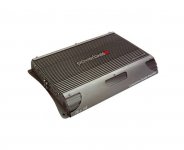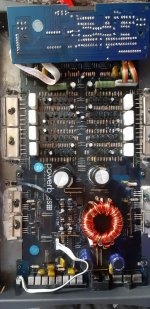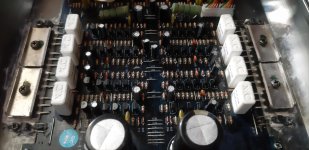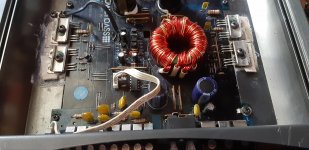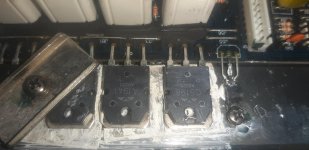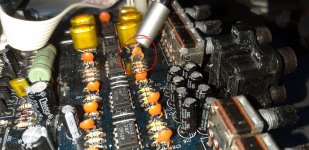Hi DIY-ers.
Firstly, thanks to those responsible for hosting such an inspirational and informative site. 2nd, I have never repaired or built an audio amp successfully, and lack the confidence to do so. I hope this will be my first.
Str8 to it ->
I cant say when or how the fault happened, just that it started to put out a very crackly distortion sound on 3 of the 4 channels. Strange that 1 ch Is working 95%.
There was a 33nf ceramic cap that showed zero continuity when tested. I replaced it with the exact same value. And just for peace of mind I reached the 3300uf 50v caps with 2 x 4700uf 50v caps. Upon testing after putting it back together, all channels were clear and worked, and then went back to the same way it sounded before.
If anyone needs specific pics please dont hesitate to ask. Any idea on where to start investigating?
Thanks in advance...
Firstly, thanks to those responsible for hosting such an inspirational and informative site. 2nd, I have never repaired or built an audio amp successfully, and lack the confidence to do so. I hope this will be my first.
Str8 to it ->
I cant say when or how the fault happened, just that it started to put out a very crackly distortion sound on 3 of the 4 channels. Strange that 1 ch Is working 95%.
There was a 33nf ceramic cap that showed zero continuity when tested. I replaced it with the exact same value. And just for peace of mind I reached the 3300uf 50v caps with 2 x 4700uf 50v caps. Upon testing after putting it back together, all channels were clear and worked, and then went back to the same way it sounded before.
If anyone needs specific pics please dont hesitate to ask. Any idea on where to start investigating?
Thanks in advance...
Attachments
Continuity isn't a good term to use for electronics. Zero continuity would be what you'd want to read with a multimeter.
If your meter is set to ohms/resistance, give the precise meter reading and the unit ohms.
If your meter is set to diode-check, give the precise meter reading and the unit volts.
Precisely which ceramic cap did you replace (show on photo)?
Don't blindly replace perfectly good parts, like the capacitors. increasing the capacitance did nothing.
Are you saying that the amp is back to working 95% on one channel (what 5% did it lose) and distorted on the other channels?
If you push on various parts of the board with a non-conductive probe, does anything change? It will need to be connected to a signal source and speakers.
If your meter is set to ohms/resistance, give the precise meter reading and the unit ohms.
If your meter is set to diode-check, give the precise meter reading and the unit volts.
Precisely which ceramic cap did you replace (show on photo)?
Don't blindly replace perfectly good parts, like the capacitors. increasing the capacitance did nothing.
Are you saying that the amp is back to working 95% on one channel (what 5% did it lose) and distorted on the other channels?
If you push on various parts of the board with a non-conductive probe, does anything change? It will need to be connected to a signal source and speakers.
Hi Perry.
Thank you for the feedback.
I'll be sure to be more thorough in my explanations. When I set the multimeter to capacitance, diode and resistance there was zero reading. When I removed it the one leg had been snapped/broken off. I replaced it with the same value, but slightly lower temp rating ceramic capacitor. This was for the interim just to check if it resolved the issue. As for the 4700uf caps, before I found DIY Audio on another forum someone suggested I replace all caps, I didn't have caps that would fit in the amp aside from these ones. Should I put the originals back? And i have not proved any part of the amp while it has been powered on, should i push on component legs to check conductivity?
The amp was putting out clear signal on all channels after I replaced the ceramic cap, now it's back to only the 1 channel producing a clear signal, but it cant reach its full potential of 60w rms on a 4ohm speaker without distorting like the other channels do.
Eagerly awaiting your reply...
Thank you for the feedback.
I'll be sure to be more thorough in my explanations. When I set the multimeter to capacitance, diode and resistance there was zero reading. When I removed it the one leg had been snapped/broken off. I replaced it with the same value, but slightly lower temp rating ceramic capacitor. This was for the interim just to check if it resolved the issue. As for the 4700uf caps, before I found DIY Audio on another forum someone suggested I replace all caps, I didn't have caps that would fit in the amp aside from these ones. Should I put the originals back? And i have not proved any part of the amp while it has been powered on, should i push on component legs to check conductivity?
The amp was putting out clear signal on all channels after I replaced the ceramic cap, now it's back to only the 1 channel producing a clear signal, but it cant reach its full potential of 60w rms on a 4ohm speaker without distorting like the other channels do.
Eagerly awaiting your reply...
Push on the board.
I think you have a bad connection somewhere. The amp started working after you worked on it because the connection intermittently restored the connection.
It won't make a difference whether you reinstall the old caps or not. As long as you understand that blindly replacing perfectly good parts doesn't do much.
Have you operated all pots and switches through their entire range while listening for audio to see if it every played through (even just for an instant)?
I think you have a bad connection somewhere. The amp started working after you worked on it because the connection intermittently restored the connection.
It won't make a difference whether you reinstall the old caps or not. As long as you understand that blindly replacing perfectly good parts doesn't do much.
Have you operated all pots and switches through their entire range while listening for audio to see if it every played through (even just for an instant)?
I'm going to follow your instructions shortly. As for this:
"Have you operated all pots and switches through their entire range while listening for audio to see if it every played through (even just for an instant)?"
If you mean have I adjusted the pots and flipped the switches whilst investigating the cause of the issue? No, not really. When I hear bad distortion and it's still there when I adjust the gain, low/high pass and I know the low output converter is set to absolute minimum, I immediately switch it off.
I'll fiddle with some knobs later this evening after I have probed the circuit board with a twizzel-stick. As for the caps, I understand fully. Thanks for reinforcing that. It was a shot in the dark. I decided earlier that any amps I repair with the help from this forum and I end up selling, i will happily spend the money in the DIY Audio store. Recently i had an opportunity to buy 7 faulty amplifiers for next to nothing, and I saw a guy selling 40 + faulty home audio amps in just up the road from me for R9000 = $613.
Thanks again Mr. Babin
I'll report back with my findings
"Have you operated all pots and switches through their entire range while listening for audio to see if it every played through (even just for an instant)?"
If you mean have I adjusted the pots and flipped the switches whilst investigating the cause of the issue? No, not really. When I hear bad distortion and it's still there when I adjust the gain, low/high pass and I know the low output converter is set to absolute minimum, I immediately switch it off.
I'll fiddle with some knobs later this evening after I have probed the circuit board with a twizzel-stick. As for the caps, I understand fully. Thanks for reinforcing that. It was a shot in the dark. I decided earlier that any amps I repair with the help from this forum and I end up selling, i will happily spend the money in the DIY Audio store. Recently i had an opportunity to buy 7 faulty amplifiers for next to nothing, and I saw a guy selling 40 + faulty home audio amps in just up the road from me for R9000 = $613.
Thanks again Mr. Babin
I'll report back with my findings
